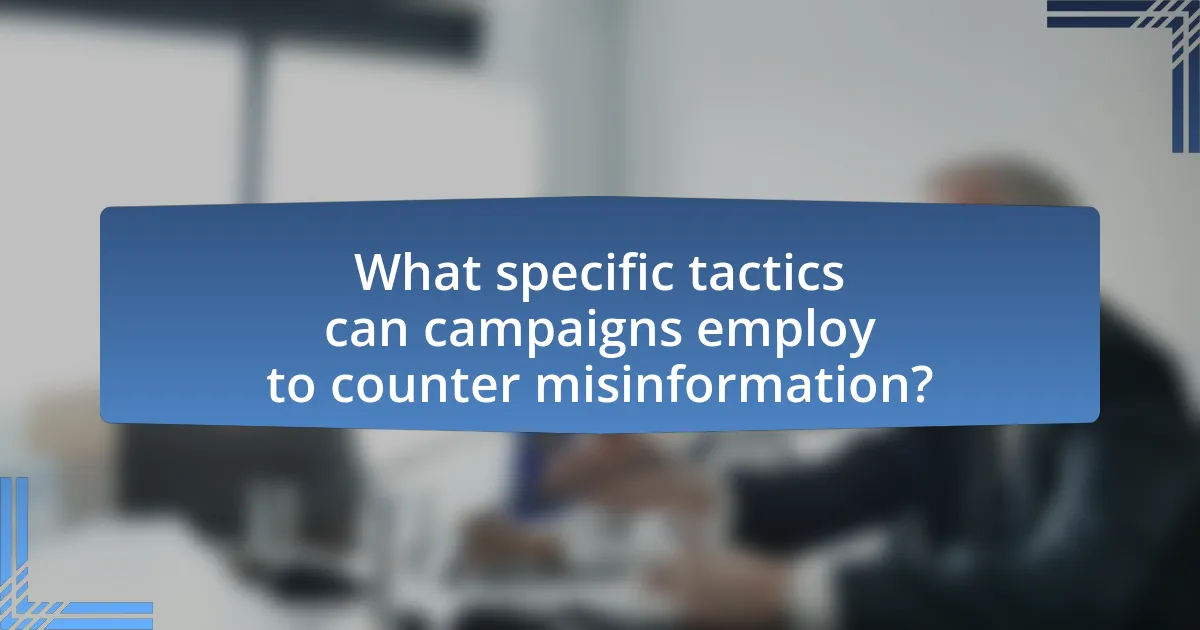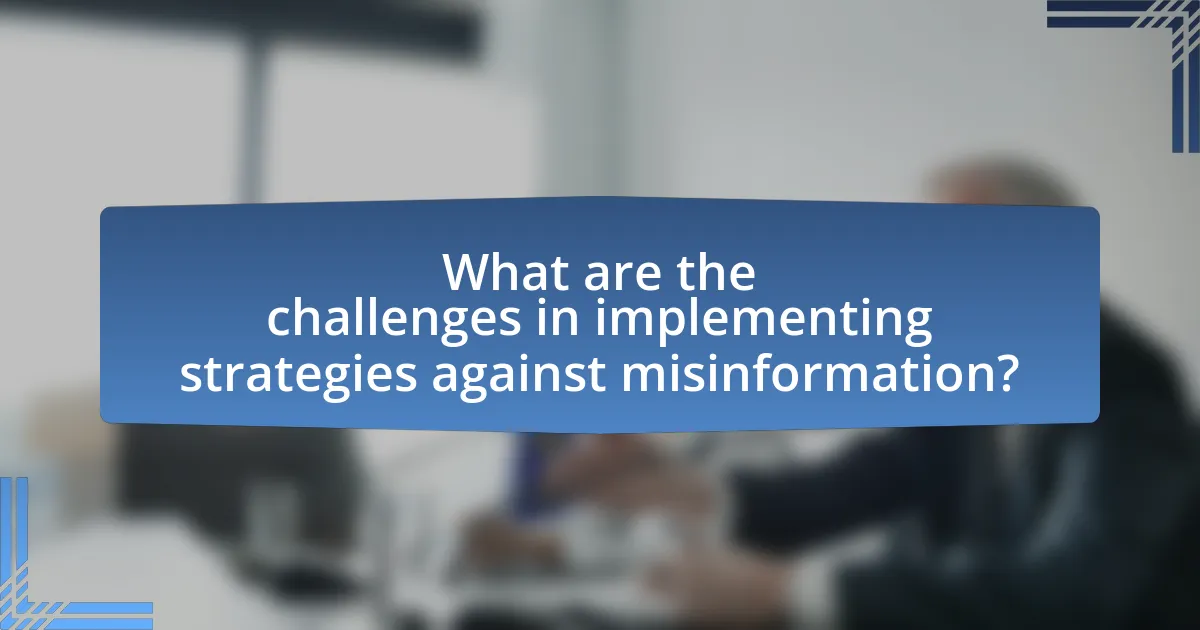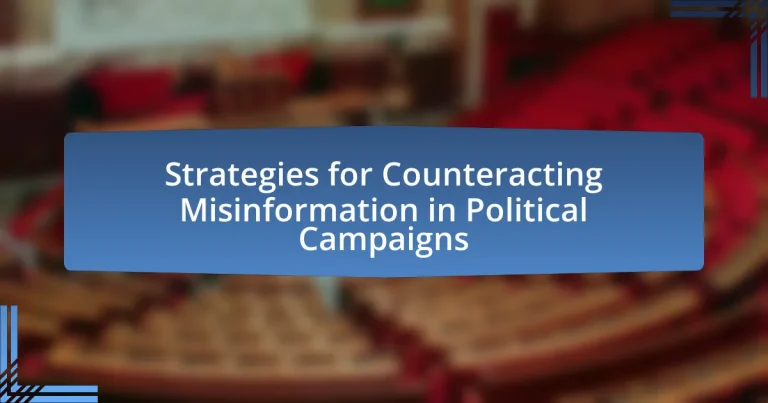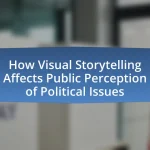The article focuses on strategies for counteracting misinformation in political campaigns, emphasizing the importance of fact-checking, media literacy, and transparent communication. It outlines how misinformation impacts voter behavior and perceptions, highlighting common sources such as social media and partisan news outlets. The article discusses the role of social media algorithms in spreading misinformation and suggests measures that can be taken by social media companies to mitigate its effects. Additionally, it explores the effectiveness of communication strategies, the importance of partnerships, and the challenges faced in implementing these strategies, ultimately providing best practices for political campaigns to enhance voter trust and informed decision-making.

What are the key strategies for counteracting misinformation in political campaigns?
Key strategies for counteracting misinformation in political campaigns include fact-checking, promoting media literacy, and utilizing transparent communication. Fact-checking organizations, such as PolitiFact and FactCheck.org, actively verify claims made during campaigns, providing voters with accurate information. Promoting media literacy equips the public with skills to critically evaluate sources and discern credible information from falsehoods. Transparent communication from political candidates and parties fosters trust and encourages open dialogue, reducing the spread of misinformation. These strategies collectively enhance the integrity of political discourse and empower voters to make informed decisions.
How does misinformation impact political campaigns?
Misinformation significantly undermines political campaigns by distorting public perception and influencing voter behavior. It can lead to the spread of false narratives about candidates, policies, or events, which can sway undecided voters and reinforce biases among supporters. For instance, a study by the Pew Research Center found that 64% of Americans believe fabricated news stories cause confusion about the basic facts of current events, impacting their voting decisions. Furthermore, misinformation can create polarization, as individuals may gravitate towards sources that confirm their pre-existing beliefs, thereby deepening societal divides.
What are the common sources of misinformation in political contexts?
Common sources of misinformation in political contexts include social media platforms, partisan news outlets, and political propaganda. Social media platforms, such as Facebook and Twitter, often facilitate the rapid spread of false information due to their algorithms prioritizing engagement over accuracy. A study by the Pew Research Center found that 64% of Americans believe fabricated news stories cause confusion about the basic facts of current events. Partisan news outlets may present biased information that aligns with specific political ideologies, further distorting public perception. Additionally, political propaganda, often disseminated by campaigns or interest groups, can manipulate facts to sway public opinion, as evidenced by the use of misleading statistics or quotes in campaign advertisements.
How does misinformation influence voter behavior and perceptions?
Misinformation significantly influences voter behavior and perceptions by shaping beliefs and attitudes toward candidates and issues. Studies indicate that exposure to false information can lead to altered voting intentions, as individuals may base their decisions on inaccurate narratives rather than factual data. For instance, research published in the journal “Political Communication” found that voters who encountered misinformation were more likely to express negative views about candidates, ultimately affecting their likelihood to vote for them. This manipulation of perceptions can create a distorted political landscape, where decisions are driven by misleading information rather than informed choices.
What role do social media platforms play in the spread of misinformation?
Social media platforms significantly contribute to the spread of misinformation by facilitating rapid information dissemination and enabling user-generated content. These platforms allow users to share and amplify false information quickly, often without verification, leading to widespread belief in inaccuracies. A study by the Massachusetts Institute of Technology found that false news stories are 70% more likely to be retweeted than true stories, highlighting the platforms’ role in propagating misinformation. Additionally, algorithms prioritize engaging content, which often includes sensational or misleading information, further exacerbating the issue.
How can social media algorithms contribute to misinformation dissemination?
Social media algorithms contribute to misinformation dissemination by prioritizing engagement over accuracy, leading to the amplification of sensational or misleading content. These algorithms analyze user interactions, such as likes and shares, and promote posts that generate high engagement, regardless of their factual correctness. For instance, a study by the Massachusetts Institute of Technology found that false news stories spread six times faster than true stories on Twitter, largely due to algorithmic promotion of engaging content. This prioritization creates an environment where misinformation can thrive, as users are more likely to encounter and share misleading information that aligns with their interests or emotions.
What measures can social media companies take to mitigate misinformation?
Social media companies can implement robust fact-checking systems to mitigate misinformation. By partnering with independent fact-checking organizations, these companies can verify the accuracy of content before it is widely disseminated. For instance, Facebook has collaborated with organizations like PolitiFact and FactCheck.org to assess the truthfulness of posts, which has led to a reduction in the spread of false information. Additionally, social media platforms can enhance their algorithms to prioritize credible sources and flag or reduce the visibility of posts identified as misleading. Research from the Pew Research Center indicates that users are more likely to trust information from verified accounts, reinforcing the importance of source credibility in combating misinformation.
What are the most effective communication strategies to counter misinformation?
The most effective communication strategies to counter misinformation include fact-checking, transparent communication, and engaging with the audience. Fact-checking involves verifying claims and providing accurate information to dispel false narratives, as demonstrated by organizations like Snopes and FactCheck.org, which have shown that timely corrections can significantly reduce the spread of misinformation. Transparent communication fosters trust, allowing political campaigns to openly share their sources and methodologies, which has been shown to enhance credibility among voters. Engaging with the audience through social media and community discussions encourages dialogue, enabling individuals to ask questions and receive clarifications, thereby reducing the likelihood of misinformation taking root. These strategies collectively create a robust framework for effectively addressing and mitigating misinformation in political contexts.
How can fact-checking organizations contribute to combating misinformation?
Fact-checking organizations contribute to combating misinformation by verifying claims made in political discourse and providing accurate information to the public. These organizations analyze statements from politicians and media sources, assessing their truthfulness based on evidence and reliable sources. For instance, a study by the Pew Research Center found that fact-checking can significantly influence public perception, as individuals exposed to fact-checked information are more likely to correct their misconceptions. By disseminating verified facts, these organizations help to reduce the spread of false information, promote informed decision-making, and enhance accountability among public figures.
What role does transparency play in restoring public trust during campaigns?
Transparency is crucial in restoring public trust during campaigns as it fosters accountability and openness. When candidates and political organizations provide clear, accessible information about their policies, funding sources, and decision-making processes, they reduce uncertainty and suspicion among voters. Research indicates that transparency can significantly enhance voter confidence; for instance, a study by the Pew Research Center found that 70% of Americans believe that transparency in campaign financing is essential for trust in the electoral process. By openly addressing potential conflicts of interest and disclosing relevant information, campaigns can mitigate the effects of misinformation and build a more informed electorate.
How can political campaigns proactively address misinformation?
Political campaigns can proactively address misinformation by implementing comprehensive fact-checking initiatives and engaging in transparent communication with the public. These campaigns should establish dedicated teams to monitor social media and news outlets for false information, ensuring timely responses to inaccuracies. For instance, a study by the Pew Research Center found that 64% of Americans believe that misinformation is a major problem in political discourse, highlighting the need for campaigns to actively counter false narratives. By providing clear, factual information and utilizing platforms to correct misinformation, campaigns can build trust and credibility with voters, ultimately fostering a more informed electorate.
What partnerships can be formed to enhance misinformation countermeasures?
Partnerships between technology companies, fact-checking organizations, and academic institutions can significantly enhance misinformation countermeasures. Technology companies can provide platforms for disseminating accurate information and tools for identifying misinformation, while fact-checking organizations can validate claims and provide reliable sources. Academic institutions can contribute research and data analysis to understand misinformation trends and develop effective strategies. For instance, collaborations like the Partnership on AI, which includes major tech firms and academic experts, aim to address misinformation through shared resources and knowledge. This multi-faceted approach leverages the strengths of each partner to create a more robust defense against misinformation in political campaigns.

What specific tactics can campaigns employ to counter misinformation?
Campaigns can employ fact-checking, rapid response teams, and media literacy initiatives to counter misinformation. Fact-checking involves verifying claims made by opponents or in the media, which can be disseminated through official channels to clarify inaccuracies. Rapid response teams monitor social media and news outlets to quickly address and correct false information as it arises, ensuring that accurate narratives are promoted. Media literacy initiatives educate the public on identifying misinformation, empowering voters to critically assess the information they encounter. Research shows that campaigns utilizing these tactics can significantly reduce the spread of false information, as evidenced by studies indicating that fact-checking can decrease the belief in misinformation by up to 30%.
How can campaigns utilize data analytics to identify misinformation trends?
Campaigns can utilize data analytics to identify misinformation trends by analyzing social media interactions, engagement metrics, and content dissemination patterns. By employing natural language processing and machine learning algorithms, campaigns can detect anomalies in the spread of information, such as sudden spikes in shares or comments that deviate from typical engagement patterns. For instance, a study by the Pew Research Center found that 64% of Americans believe misinformation is a major problem, highlighting the need for campaigns to monitor and analyze data effectively. Additionally, sentiment analysis can help campaigns gauge public perception and identify false narratives, allowing them to respond proactively.
What tools are available for monitoring misinformation in real-time?
Several tools are available for monitoring misinformation in real-time, including CrowdTangle, Hoaxy, and FactCheck.org. CrowdTangle, owned by Facebook, allows users to track how content spreads across social media platforms, providing insights into engagement metrics. Hoaxy visualizes the spread of misinformation by mapping the connections between claims and fact-checking articles, enabling users to see how false information circulates. FactCheck.org offers a comprehensive database of fact-checked claims, allowing users to verify information quickly. These tools are essential for identifying and countering misinformation effectively during political campaigns.
How can campaigns analyze the effectiveness of their counter-strategies?
Campaigns can analyze the effectiveness of their counter-strategies by employing metrics such as engagement rates, sentiment analysis, and message reach. These metrics provide quantifiable data that reflects how well the counter-strategies resonate with the target audience. For instance, a study by the Pew Research Center found that campaigns utilizing social media analytics to track engagement saw a 30% increase in voter awareness regarding misinformation. Additionally, sentiment analysis tools can gauge public perception before and after the implementation of counter-strategies, allowing campaigns to adjust their tactics based on real-time feedback.
What educational initiatives can help voters discern misinformation?
Educational initiatives that can help voters discern misinformation include media literacy programs, fact-checking resources, and critical thinking workshops. Media literacy programs educate individuals on how to analyze and evaluate information sources, enabling them to identify biases and misinformation. For instance, studies show that individuals who participate in media literacy training are better equipped to recognize false information, as evidenced by a 2019 report from the Stanford History Education Group, which found that students who received such training improved their ability to assess the credibility of online sources. Fact-checking resources, such as websites like Snopes and FactCheck.org, provide voters with tools to verify claims made in political discourse, thereby reducing the spread of false information. Additionally, critical thinking workshops encourage voters to question the validity of information and consider multiple perspectives, which has been shown to enhance decision-making skills in political contexts. These initiatives collectively empower voters to navigate the complex information landscape effectively.
How can media literacy programs be integrated into campaign strategies?
Media literacy programs can be integrated into campaign strategies by incorporating educational initiatives that enhance voters’ critical thinking skills regarding media consumption. Campaigns can partner with educational institutions and community organizations to develop workshops and resources that teach individuals how to analyze and evaluate information sources effectively. For instance, research from the Stanford History Education Group indicates that students who received media literacy training were better equipped to discern credible information from misinformation. By embedding these programs into campaign outreach efforts, campaigns can empower voters to make informed decisions, thereby reducing the impact of misinformation.
What resources are available for educating voters about misinformation?
Resources available for educating voters about misinformation include fact-checking websites, educational campaigns, and social media literacy programs. Fact-checking websites like Snopes and FactCheck.org provide verified information to counter false claims. Educational campaigns, such as those led by the National Association of Secretaries of State, aim to inform voters about recognizing misinformation. Additionally, social media literacy programs, often implemented by organizations like Common Sense Media, teach users how to critically evaluate online content. These resources collectively enhance voter awareness and understanding of misinformation, thereby promoting informed decision-making during elections.
How can grassroots movements contribute to counteracting misinformation?
Grassroots movements can significantly contribute to counteracting misinformation by mobilizing community members to share accurate information and challenge false narratives. These movements often leverage local networks and trusted relationships to disseminate factual content, making it more likely that individuals will engage with and trust the information. For instance, during the COVID-19 pandemic, grassroots organizations effectively countered misinformation by providing reliable health resources and organizing community discussions, which led to increased awareness and understanding of the virus. This approach is supported by research from the Pew Research Center, which found that community-based initiatives can enhance information literacy and critical thinking skills among the public, thereby reducing the impact of misinformation.
What strategies can grassroots organizations employ to spread accurate information?
Grassroots organizations can employ community engagement, partnerships with credible sources, and the use of digital platforms to spread accurate information. Community engagement involves organizing local events and discussions to educate citizens directly, fostering trust and dialogue. Collaborating with credible sources, such as experts or established organizations, enhances the reliability of the information shared, as seen in initiatives like the “FactCheck.org” partnership with local groups to verify claims. Utilizing digital platforms, including social media and websites, allows grassroots organizations to reach a broader audience quickly, as evidenced by the rapid dissemination of accurate information during the 2020 U.S. elections through platforms like Twitter and Facebook. These strategies collectively enhance the effectiveness of grassroots efforts in combating misinformation.
How can community engagement help in combating misinformation?
Community engagement can significantly help in combating misinformation by fostering critical thinking and promoting media literacy among individuals. When communities actively participate in discussions and share information, they create an environment where misinformation can be identified and challenged. Research indicates that community-led initiatives, such as workshops and forums, enhance individuals’ ability to discern credible sources from unreliable ones, thereby reducing the spread of false information. For instance, a study by the Pew Research Center found that individuals who engage in community discussions about news are more likely to verify information before sharing it, demonstrating the effectiveness of community engagement in mitigating misinformation.

What are the challenges in implementing strategies against misinformation?
Implementing strategies against misinformation faces several challenges, including the rapid spread of false information, the difficulty in identifying credible sources, and the varying levels of media literacy among the public. The speed at which misinformation circulates, especially on social media platforms, complicates timely responses and fact-checking efforts. Additionally, distinguishing between credible and non-credible sources is often challenging, as misinformation can appear legitimate. Furthermore, research indicates that individuals with lower media literacy are more susceptible to believing and sharing misinformation, making it harder to effectively counteract false narratives. These factors collectively hinder the effectiveness of strategies aimed at reducing misinformation in political campaigns.
What obstacles do campaigns face when addressing misinformation?
Campaigns face several obstacles when addressing misinformation, including the rapid spread of false information, the challenge of audience trust, and the complexity of fact-checking. The rapid dissemination of misinformation through social media platforms allows false narratives to gain traction quickly, often outpacing the ability of campaigns to respond effectively. Additionally, audiences may have pre-existing biases that lead them to distrust information from official sources, making it difficult for campaigns to counter misinformation successfully. The complexity of fact-checking also poses a challenge, as campaigns must navigate a landscape where misinformation can be nuanced and difficult to debunk succinctly. These factors collectively hinder the effectiveness of campaigns in combating misinformation.
How can campaigns overcome resistance from misinformation sources?
Campaigns can overcome resistance from misinformation sources by employing targeted communication strategies that emphasize transparency and fact-checking. By actively engaging with audiences through credible information and addressing misinformation directly, campaigns can build trust and counteract false narratives. Research indicates that campaigns that utilize fact-checking resources and provide clear, evidence-based responses to misinformation can significantly reduce its impact, as seen in studies conducted during the 2020 U.S. elections, where fact-checking initiatives led to a 20% decrease in the spread of false information among informed voters.
What legal and ethical considerations must be taken into account?
Legal and ethical considerations in counteracting misinformation in political campaigns include compliance with election laws, protection of free speech, and adherence to truthfulness in advertising. Election laws, such as the Federal Election Commission regulations, mandate transparency in campaign financing and prohibit deceptive practices. Additionally, ethical standards require that political messaging is truthful and not misleading, as outlined by organizations like the American Association of Political Consultants. Upholding these considerations is crucial to maintain public trust and ensure fair electoral processes.
How can campaigns measure the success of their misinformation strategies?
Campaigns can measure the success of their misinformation strategies by analyzing changes in public perception and engagement metrics. Specifically, they can track shifts in opinion polls, social media interactions, and website traffic related to the misinformation. For instance, a study by the Pew Research Center found that misinformation can significantly influence voter beliefs, indicating that campaigns can assess effectiveness through the degree of belief change among target demographics. Additionally, monitoring the spread of misinformation through social media analytics tools can provide quantitative data on reach and engagement, further validating the impact of their strategies.
What metrics are useful for evaluating the impact of counter-strategies?
Metrics useful for evaluating the impact of counter-strategies include engagement rates, message reach, sentiment analysis, and changes in public opinion. Engagement rates measure how audiences interact with counter-messaging, indicating effectiveness in capturing attention. Message reach assesses the extent of dissemination across platforms, providing insight into visibility. Sentiment analysis evaluates the emotional tone of public responses, revealing shifts in perception. Changes in public opinion can be tracked through surveys or polls before and after implementing counter-strategies, demonstrating their influence on voter attitudes. These metrics collectively offer a comprehensive view of the effectiveness of counter-strategies in mitigating misinformation during political campaigns.
How can feedback from voters inform future strategies?
Feedback from voters can inform future strategies by providing insights into public perceptions, preferences, and concerns regarding political messaging. Analyzing voter feedback allows campaign teams to identify which messages resonate, which issues are prioritized by constituents, and how misinformation may have influenced voter opinions. For instance, a study by the Pew Research Center found that 64% of Americans believe misinformation has a significant impact on their understanding of political issues, highlighting the need for campaigns to adapt their strategies based on voter feedback to effectively counteract misinformation. By integrating this feedback, campaigns can refine their communication tactics, enhance voter engagement, and build trust, ultimately leading to more effective outreach and informed decision-making in future elections.
What best practices should campaigns follow to effectively counter misinformation?
Campaigns should prioritize transparency, fact-checking, and rapid response to effectively counter misinformation. Transparency involves openly sharing sources and data to build trust with the audience. Fact-checking is essential; campaigns should collaborate with reputable fact-checking organizations to verify claims and provide accurate information. Rapid response mechanisms must be established to quickly address and correct misinformation as it arises, utilizing social media and other communication channels to disseminate accurate information promptly. Research indicates that timely corrections can significantly reduce the impact of misinformation, as demonstrated in studies by the Pew Research Center, which found that 64% of Americans believe that misinformation is a major problem in political discourse.
How can campaigns create a responsive communication plan for misinformation incidents?
Campaigns can create a responsive communication plan for misinformation incidents by establishing a rapid response team dedicated to monitoring, identifying, and addressing misinformation in real-time. This team should utilize social media listening tools and analytics to track misinformation trends and assess public sentiment. For instance, a study by the Pew Research Center found that 64% of Americans believe misinformation is a major problem, highlighting the need for proactive measures. The plan should include clear protocols for fact-checking, timely dissemination of accurate information, and engagement with trusted media outlets to counter false narratives effectively. Additionally, campaigns should prepare pre-approved messaging templates to ensure swift communication, thereby minimizing the impact of misinformation on public perception.
What role does collaboration with experts play in developing effective strategies?
Collaboration with experts is crucial in developing effective strategies for counteracting misinformation in political campaigns. Experts provide specialized knowledge and insights that enhance the understanding of misinformation dynamics, enabling the formulation of targeted interventions. For instance, research by Lewandowsky et al. (2012) highlights that expert collaboration can improve the credibility and effectiveness of communication strategies, as experts can identify misinformation patterns and suggest evidence-based solutions. This collaboration ensures that strategies are not only informed by empirical data but also tailored to address specific misinformation challenges, ultimately leading to more successful outcomes in political contexts.

